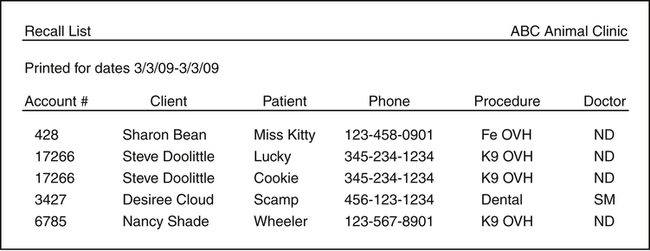CHAPTER 11
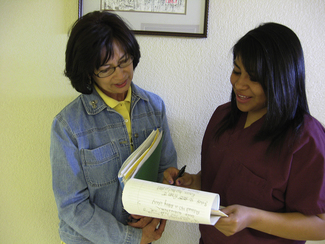
Client Communications
Mastery of the content in this chapter will enable the reader to:
• Describe the importance of written client materials.
• Describe the importance of professional verbal skills.
• List methods used to communicate in a positive, professional manner.
• Identify methods used to educate clients with a variety of techniques.
• Describe the importance of providing estimates for clients.
• Clarify barriers that prevent effective client communication.
Client communication comes in a variety of forms. It starts in the front office with the reception team. Greeting clients as they enter the practice communicates that the staff acknowledges their presence. Communication should occur in a positive, friendly manner, which enhances the practice image. Communication includes both verbal and written forms in the exam rooms. The veterinarians, technicians, and assistants must educate the client with words that can be understood, but must take care to not offend. Many clients want to learn the information but do not understand medical terminology. The amount of information given to clients can be based on the clients’ knowledge and skill (Figure 11-1).
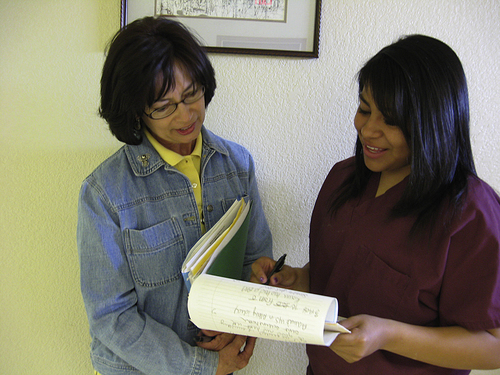
Written communication includes all client education materials. Clients should take home information with every visit. After puppy and kitten exams, clients should be sent home with material informing them about internal parasites and vaccination schedules. Clients bringing pets in for follow-up booster examinations may be sent home with information on nutrition as well as on the benefits of spaying and neutering. The last visit may include information on the prevention of obesity and dental disease. Yearly exam patients may need to be educated on weight-loss programs and nutritional and behavioral issues. Senior patients should be educated on the importance of monitoring bloodwork and frequent, regular exams. Each client should receive a report card explaining the normal and abnormal findings for his or her pet and what follow-up procedures or treatments are recommended (see Figure 10-11).
Boarding clients will appreciate receiving report cards on their pets, which may include information on the pets’ appetite, activity level, and attitude (Figure 11-2).
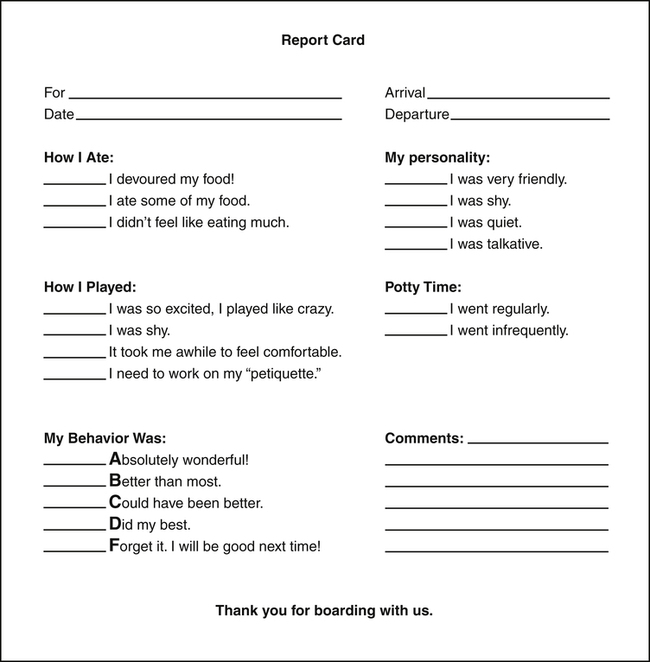
VERBAL AND WRITTEN SKILLS
Team members should be able to communicate well with clients verbally. Specific words may be chosen when talking with clients to project the professional image of the practice. Lower and deeper voice tones make team members appear more confident and authoritative, whereas high-pitched tones sound insecure and immature. With practice, deeper tones can be established, enhancing each team member’s value. Chapter 2 discusses telephone etiquette and effective voice tones as well as how the speed of talking can affect a conversation. Client perception starts when a call is placed to the practice and is definitely affected by the tone of the conversation.
Clients will always have questions about their pets’ health care. It is important to remember that clients are asking these questions because they do not know the answers; team members must not judge clients for asking questions. Team members forget that topics that are very basic to the team are new to an owner. Teams must not get frustrated answering these questions for clients. A client service manual is suggested to help new team members learn the appropriate answers to client questions. This includes correct verbiage, correct pronunciation, and the skill to respond to such questions. Chapter 23 covers the most common diseases and procedures that team members should be familiar with. This will help improve client communication.
Letter Etiquette
It is extremely important that staff members have excellent writing skills. Chapter 14 reviews the importance of completing medical records in a professional, legible manner. Team members must be able to verbally communicate procedures with clients, along with writing professional, educational, and clear discharge instructions for owners. The goal of written communications is to prevent miscommunications before they occur, prevent the owner from asking the same questions several times, and represent the business, ultimately increasing sales and professional services.
CLIENT COMPLIANCE
Reminders and Recall Systems
Many software programs can automatically generate reminders and recalls for the veterinary team. Smaller practices may handwrite reminders on a monthly basis. Reminders are simply that; they remind owners that pets are due for a procedure. Practices may elect to send out reminders for a variety of services, including yearly exams and/or vaccines (based on the current vaccination protocol), heartworm testing, and/or a fecal analysis (depending on the location of the practice in the United States). Practices may also send out reminders for yearly laboratory work, including testing for hypothyroidism, phenobarbital levels, or bile acids for patients that are on long-term medications that may have potential side effects if not monitored closely. From a marketing perspective, hospitals may send out reminders for senior care exams or dental month (see Chapter 10). Communications can also be sent to remind clients to refill their pets’ medication, including heartworm preventive and medications that treat hypothyroidism or hyperthyroidism, seizures, and/or allergies (Figures 11-3 and 11-4).
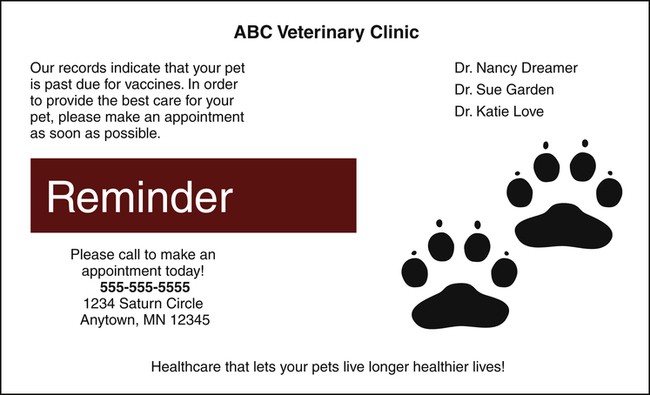
Reminder cards can be ordered from a variety of software companies or supply houses. Some systems may require a specific type of card to fit system or printer requirements; however, a variety of choices are available to choose from. Dogs, cats, puppies, and horses posing in different outfits and performing different tricks should grab a client’s attention. Chapter 10 includes more helpful reminder ideas. Manufacturers also supply reminders for their particular product or service. Merial, Novartis, and Pfizer supply reminders for their vaccines, heartworm preventives, and products.
Recalls are lists that are generated by veterinary software systems to remind staff to call certain clients to check on patients (Figure 11-5). Recalls can be created for surgical patients, pets that have received vaccines, or any patient that has been in the hospital for a period of time. Software systems allow team members to set a specific number of days for the recall to be generated. Certain charged services can also be linked to a recall generator, thereby creating a recall each time one of those services is entered. Each day, reception teams can print lists and call clients to see how patients are progressing. This is a great time to ensure that the client was satisfied with the services and answer any remaining questions. If the client has any concerns or the pet has not progressed as expected, an appointment can be made with a specific doctor to recheck the patient. Always document in the record the telephone conversation and how the pet is recovering. This allows team members to follow the case if the client needs to return for a recheck.
Stay updated, free articles. Join our Telegram channel

Full access? Get Clinical Tree


 PRACTICE POINT
PRACTICE POINT PRACTICE POINT
PRACTICE POINT PRACTICE POINT
PRACTICE POINT PRACTICE POINT
PRACTICE POINT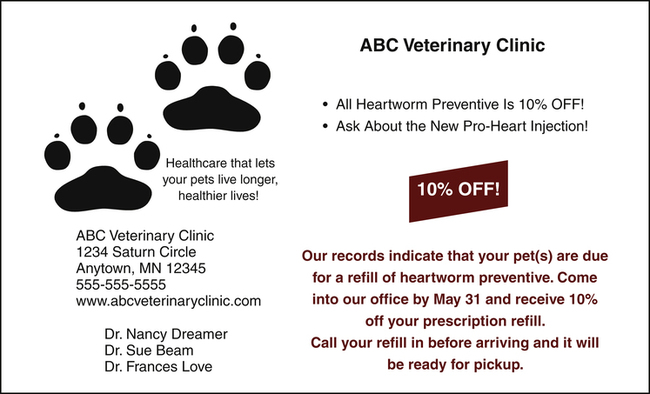
 PRACTICE POINT
PRACTICE POINT